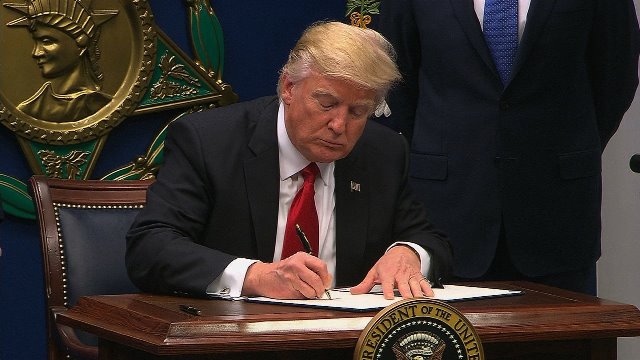President Donald Trump, concerned his travel ban could be stopped cold in the judicial branch after a less-than-stellar rollout, is leaning into fear, attempting to ratchet up terror concerns by telling audiences that he has learned considerably more about terror since taking office last month.
Trump and his top aides are well aware that his travel ban would benefit from public approval, so Trump made the case Wednesday that he knows more about terrorism than most. He suggested that Americans — at least those who don’t get classified briefings — don’t understand the terror threat against the United States.
“Terrorism is a tremendous threat, far greater than people in our country understand,” Trump told a gathering of sheriffs in a Washington hotel.
Seemingly hinting at information gleaned from his classified briefings, the President added: “Believe me. I’ve learned a lot in the last two weeks, and terrorism is a far greater threat than the people of our country understand.”
Ari Fleischer, who served as Bush’s White House press secretary during 9/11, said all presidents use “realistic, worse-case scenarios” to push their agendas.
He cautioned the tactic could be abused and result in undermining an administration.
“Like anything, you can go too far. You can exaggerate, you can get facts wrong, you can hype it to a degree where you lose credibility,” he said. “But it is been a time honored tradition in American politics to use a worst-case scenario to drive an agenda.”
It’s also a tactic that’s worked for Trump. Throughout the 2016 campaign, Trump urged his supporters to worry about terror and pushed them to do so by painting the world as an increasingly dangerous place.
“People are scared,” Trump said in his June Republican National Convention acceptance speech. “The attacks on our police, and the terrorism in our cities, threaten our very way of life. Any politician who does not grasp this danger is not fit to lead our country.”
More Americans said terrorism was a pressing concern in 2016 than any point since 2003.
According to a CNN poll released in 2016, 71% of Americans said further acts of terrorism are very or somewhat likely in the United States over the next several weeks, a number that has not been that high since March 2003.
The strategy
Trump’s strategy as President is twofold.
Alarmist language could help sell the travel ban to a skeptical public.
Trump is also suggesting he knows more about the need for the ban than the judges overseeing the legal challenges, who are not privy to confidential briefings.
Americans are largely split on Trump’s executive order, which bars citizens of seven Muslim-majority countries from entering the US for 90 days, all refugees for 120 days and indefinitely halts refugees from Syria.
Voters generally disapprove of key aspects of Trump’s order, according to a Quinnipiac University poll out Wednesday. It found 51% of the public oppose suspending travel to the US for 90 days from seven countries, 60% oppose suspending all refugee immigration for 120 days and 70% oppose indefinitely suspending the Syrian refugee program.
Trump’s order went before a 9th Circuit Court of Appeals three-judge panel on Tuesday where lawyers from Trump’s Justice Department squared up against the states of Washington and Minnesota. The court is expected to rule on Trump’s order by the end of the week.
The President knocked the arguments against his travel ban Wednesday, telling the same group of sheriffs that “even a ‘bad high school student’ ” could understand the language of his order and find in his favor.
Words of reassurance
In contrast, after high-profile attacks in San Bernardino and Paris, President Barack Obama said: “the threat from terrorism is real, but we will overcome it.”
“Let’s be vigilant, but not afraid,” Obama said in his final speech as President. “(ISIS) will try to kill innocent people. But they cannot defeat America unless we betray our Constitution and our principles in the fight.”
Even George W. Bush, whose administration did, at times, stoke fear in the run up to the Iraq War and around homeland security, was measured in the face of the 9/11 attacks.
“Now, the American people have got to go about their business. We cannot let the terrorists achieve the objective of frightening our nation to the point where we don’t conduct business, where people don’t shop,” Bush said after 9/11, the deadliest terrorist attack in US history.
Bush, in his final speech as president, said the United States was a nation “that inspires immigrants to risk everything for the dream of freedom.”
“This is a nation where citizens show calm in times of danger, and compassion in the face of suffering,” he said.
A good example of Bush using fear: His push to establish the Department of Homeland Security in 2003.
At the time, Fleischer said, Bush would regularly read his morning “threat matrix” — a document about produced by the Department of Homeland Security on possible threats — and use it publicly at times to push his plan to fight terrorism.
“With a vast nation to defend, we can neither predict nor prevent every conceivable attack,” Bush said before establishing the new government agency. “And in a free and open society, no department of government can completely guarantee our safety against ruthless killers, who move and plot in shadows. Yet our government will take every possible measure to safeguard our country and our people.”
